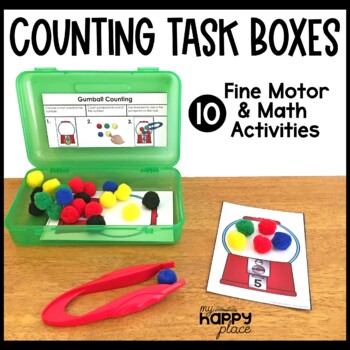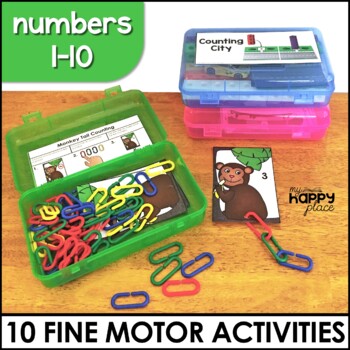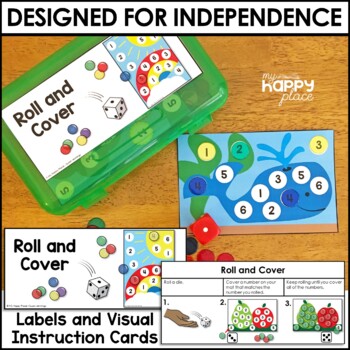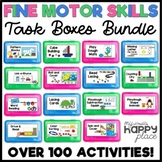Counting Fine Motor Skills Task Boxes - Morning Bins - Counting Activities
- PDF
What educators are saying
Also included in
- This bundle of over 100 fine motor activities targets the development of fine motor skills in preschool and kindergarten students while also fostering independence and excitement about school. Fine motor skills in young children are a predictor of academic success, but many students begin school stPrice $53.00Original Price $106.75Save $53.75
Description
This fine motor task boxes set is packed with 10 engaging counting activities designed to help your students master the numbers 1-10. Perfect for morning tubs, early finishers, math centers, or busy boxes, this set of counting activities targets the development of standards-aligned math concepts and fine motor skills in preschool and kindergarten students while also fostering independence and excitement about school. Designed to be completed independently, these fine motor activities build finger strength, dexterity, and coordination while giving you time to take care of some of the many other tasks that demand your attention each day!
These Counting Fine Motor Skills Task Boxes are part of a bundle.
These Counting Fine Motor Task Boxes Include:
This set includes ideas and printable materials for 10 fine motor counting activities. Each task is designed to fit into a standard plastic pencil box and includes a printable label, picture directions, and other materials (such as work mats or task cards). The tasks in this set are intended to help your students master kindergarten counting and cardinality standards but are appropriate for any child that needs practice with the numbers 1-10.
The included counting activities are:
▶ Ice Cream Shop Counting Mats
Students use pompoms to fill ice cream orders on ice cream cones and sundae cards.
▶ Pattern Block Counting Puzzles
Students count pattern blocks and use them to complete simple puzzles.
▶ Counting Clip Cards
Students count and use clothespins to mark their answer.
▶ Gumball Counting Mats
Students use pompoms or circular counters to complete gumball task cards.
▶ Caterpillar Counting Mats
Students use pompoms or circular counters to complete caterpillar task cards.
▶ Monkey Tail Counting Cards
Students count and use plastic chain links to add tails to monkey cards.
▶ Roll and Cover Mats
Students roll a six-sided die and use counters to mark the matching number on the picture card.
▶ Counting City
Students connect snap cubes to make towers that match the numbers on city cards.
▶ Playdough Number Mats
Students manipulate dough to form numerals and dots.
▶ Comparing Numbers Clip Cards
Students use clothespins to mark the number or quantity that is greater.
How to Use These Fine Motor Activities:
Once you get your students started with these task boxes with some initial instructions, they will be up and running and ready for independence! These counting fine motor task boxes are perfect to grab during any of the times that you need students to be independent, engaged, and productive. Use these simple fine motor activities as morning tubs when students arrive in the classroom (a soft start is a great way to let students gently adjust to the school day) or as early finishers for children who finish their work quickly. These counting activities are also useful during math center time, indoor recess, or any time students need a quiet break to re-focus.
To prepare these Counting Fine Motor Task Boxes, print and laminate the activity label and instructions as well as the printable activity materials. Attach the activity label to the outside of the box and the illustrated instruction card inside the lid. (You can use Velcro to attach the labels if you want to have the flexibility to easily switch activities throughout the year!) Place all listed materials inside the box. Each activity requires the inclusion of other classroom items such as manipulatives or basic classroom supplies (listed below).
Once assembled, these fine motor activities stack easily on a shelf. Teach your students what procedures you would like them to follow for use and clean up. Some teachers allow students to come into the classroom and quietly select any of the morning tubs, while others prefer a check-in/out system that encourages children to cycle through the activities. Another option is to make a selection of task boxes available at each table and rotate them as the week goes on. This option can cut down on transition time and allow students to quickly choose an early finisher or math center activity.
What Teachers Are Saying:
⭐⭐⭐⭐⭐ “This may be the BEST purchase I've ever made! The activities are colorful, engaging and purposeful. I assigned a new task box to each student each day. They spent the first 15 minutes of each day doing their task. It was a routine they learned easily and could do independently. I went on to purchase ALL the fine motor task box resources created by ‘My Happy Place.’” -Kathleen R.
⭐⭐⭐⭐⭐ “Absolutely amazing resource. I have this one and the one with reading as well. Both sets are wildly popular with my students, and I have used them both as table time activities that I set out, free-choice activities they can choose from the free-choice shelf, and also for some of my younger students who maybe are having a day where they need some calm time, or time to just reset, I will use one in our calming area and sit with the student or nearby. This helps them focus, reset, and not feel in trouble. Thank you for such an awesome resource!” –Jennifer K.
⭐⭐⭐⭐⭐ "All of my Kindergarten students enjoyed using these math and fine motor task boxes after they have completed their work and/or during math centers. They are right on target for creating a learning and engaging environment during math small group time and/or one on one time. Fun and educational learning took place, and I plan on using it for many years to come.” –Andrea D.
Recommended Materials List (not included in purchase):
copy paper, card stock, laminator/film
craft pompoms
1 plastic spoon
pattern blocks (10 orange squares, 10 green triangles, 8 tan skinny rhombuses, 7 blue rhombuses, 6 red trapezoids, 4 yellow hexagons)
clothespins
3/4” circular transparent counters
math links (learning links)
55 connecting cubes (linking cubes)
small toy car(s) (optional)
playdough
child tweezers
Why are fine motor skills important?
Research shows that well-developed fine motor skills in young children are a predictor of academic success. It makes sense that children with dexterity and hand strength would be more successful in a classroom that requires writing and drawing, but researchers have found that the connection goes beyond that. Through a series of studies using longitudinal data that tracked students from kindergarten through eighth grade, researchers determined that strong fine motor skills in the early years of life help form connections in the brain that lead to greater academic achievement throughout the school years. Unfortunately, advances in technology have led many families away from traditional activities that promote fine motor development. The time that many children spend using computers, tablets, and smartphones is time that they are not spending building, drawing, and manipulating objects in the world around them. Many children are beginning school with a deficit of motor skills, both gross and fine. It is important for schools to give children many opportunities to build those skills.
You may also like:
▶ Kindergarten Math Centers: Counting and Numbers 1-10
▶ Kindergarten Counting and Cardinality Unit
▶ Teen Numbers Fine Motor Skills Task Boxes
▶ Kindergarten Math Centers: Teen Numbers
Please see the preview file for more detailed images. If you have any questions, email susan@myhappyplaceteaching.com or use the “Q&A” feature on this page.
I would love to have you as a follower! Click the green star to be the first to know about new resources.
Thank you for shopping!
Susan Jennings (My Happy Place)
___________________________________
Copyright © My Happy Place Teaching Resources
Permission to copy for single classroom use only.
Please purchase additional licenses if you intend to share this product.






